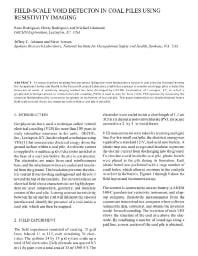Mining Publication: Field-Scale Void Detection in Coal Piles Using Resistivity Imaging
Original creation date: July 2002
Authors: R Rodriguez, H Rodriguez, M Lhamond, JC Johnson, SR Iverson
NIOSHTIC2 Number: 20030439
NARMS-TAC 2002, "Mining and Tunnelling Innovation and Opportunity," Proceedings of the 5th American Rock Mechanics Symposium and the 17th Tunnelling Association of Canada Conference, July 7-10, 2002, Toronto, Ontario, Canada. Hammah R, Bawden W, Curran J, Telesnicki M, eds., Toronto, Ontario, Canada: University of Toronto Press, 2002 Jul; 1:415-419
To reduce fatalities resulting from personnel falling into voids formed above feeders in coal piles, the National Institute for Occupational Safety and Health at the Spokane Research Laboratory established a project to monitor coal surge piles to detect the formation of voids. A resistivity imaging method has been developed by GECOH Exploration, of Lexington, KY, in which a geophysical technique known as vertical electrical sounding (VES) is used to scan for these voids. VES operates by measuring the electrical field produced by a current in the ground at the bottom of the coal pile. This paper summarizes the results obtained from a field-scale test and shows that mapping voids within a coal pile is possible.

NIOSHTIC2 Number: 20030439
NARMS-TAC 2002, "Mining and Tunnelling Innovation and Opportunity," Proceedings of the 5th American Rock Mechanics Symposium and the 17th Tunnelling Association of Canada Conference, July 7-10, 2002, Toronto, Ontario, Canada. Hammah R, Bawden W, Curran J, Telesnicki M, eds., Toronto, Ontario, Canada: University of Toronto Press, 2002 Jul; 1:415-419
- Derating Factors for Round and Flat Mine Trailing Cables
- Effect of Coal Type and Oxyfuel Combustion Parameters on Pulverised Fuel Ignition
- Gas Sorption and Transport in Coals: A Poroelastic Medium Approach
- Measuring the Gas Content of Coal: A Review
- Methane and Dust Control by Water Infusion: Pittsburgh Coalbed (Fairview, W. Va.)
- Methane Diffusion Parameters for Sized Coal Particles: A Measuring Apparatus and Some Preliminary Results
- Methane Emissions from Gassy Coals in Storage Silos
- Reducing Hazards in Underground Coal Mines Through the Recognition and Delineation of Coalbed Discontinuities Caused by Ancient Channel Processes
- Removing Methane (Degasification) from the Pocahontas No. 4 Coalbed in Southern West Virginia
- Reservoir Engineering Considerations for Coal Seam Degasification and Methane Control in Underground Mines